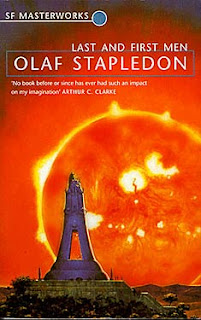British writer Olaf Stapledon spent the second half of his life pondering these sorts of issues mentioned above. A pacifist at heart, Stapledon ended up serving as an ambulance driver during World War I, where he witnessed not just the worst atrocities that human aggression and fear can afflict upon its populaces, but also some heartwarming episodes of camaraderie and shared sacrifice. He was influenced heavily by the immediate interwar writings of Oswald Spengler, among others, as his most famous work, Last and First Men (1930), displays the sort of cyclical and often pessimistic attitude toward civilizations as that found in Spengler's The Decline of the West. But whereas Spengler's work has fallen into disrepute since the beginning of World War I, Stapledon's work continues to inspire generations of SF writers, including Gregory Benford and Brian Aldiss.
Last and First Men, strictly speaking, is not a novel. There are no characters, nor is there anything remotely resembling a conventional plot. It is an imagined history of the world, from the early 20th century until the final death of the eighteenth human species two billion years into the future. Broken into sixteen chapters, this book might be best imagined as a spiral, with our present being at the center and with each turn having a wider space between the preceding layers. The first third of the novel is devoted to telling the continued rise and then fall of the First Men (homo sapiens sapiens). We see an emergent America whose capitalistic spirit threatens the fabric of the fragile peace wrought from the trenches of World War I. These first five chapters perhaps are the most dated, as Stapledon's references to then-commonly held assumptions on race and national characteristics are so foreign to our post-Auschwitz understanding of societies. It may be a dry and rough patch for readers to overcome, but once the story moves five million years into the future, after the First Men have collapsed due to environmental degradation and increased vulcanism on the Earth's surface, the story begins to become all the more compelling to read as Stapledon traces the rise and fall of several other successor human species.
To sum the matter, circumstance had thrown up a very noble species. Essentially it was of the same type as the earlier species, but it had undergone extensive improvements. Much that the First Men could only achieve by long schooling and self-discipline the Second Men performed with effortless fluency and delight. In particular, two capacities which for the First Men had been unattainable ideals were now realized in every normal individual, namely the power wholly dispassionate cognition, and the power of loving one's neighbor as oneself, without reservation. Indeed, in this respect, the Second Men might be called 'Natural Christians', so readily and constantly did they love one another in the manner of Jesus, and infuse their whole social policy with loving-kindness. Early in their career they conceived the religion of love, and they were possessed by it again and again, in diverse forms, until their end. On the other hand, their gift of dispassionate cognition helped them to pass speedily to the admiration of fate. And being by nature rigorous thinkers, they were peculiarly liable to be disturbed by the conflict between their religion of love and their loyalty to fate.
Well might it seem that the stage was now set for a triumphant and rapid progress of the human spirit. But though the second human species constituted a real improvement on the first, it lacked certain faculties without which the next great mental advance could not be made. (pp. 117-118)
The above passage is representative of the general tone and tenor of Last and First Men. Told in a distant, "historical" voice (toward the end of the book, we learn just who has been doing the telling and how their own histories have influenced the writing of this missive on the long human past), the story concentrates on detailing the attempts of various human species to rise above their current condition and the struggles, internal and external alike, that combine to defeat most of these noble goals. As the Second Men fade and the Third arise, only to beget the Fourth, more artificial human race, which is supplanted by the fifth and so forth until the eighteenth and last human species, Stapledon introduces concepts such as the conflict noted above between Love and Rationality, between altruism and a desire to defeat mortality. There are successes along the way, but most of these prove to be ephemeral. But there is something that seems to improve within most of these successor species as the two billion years allotted for humankind unfolds.
The result of this is a very powerful story that serves to make us reflect upon our own goals and aspirations. If part of being human is the quest for the seemingly unattainable, then the quixotic quests found within Last and First Men are perhaps some of the more powerfully told stories of the human race of the past century. Grounded in the troubled interwar period of the 1920s and 1930s, Last and First Men still possesses a power to move the hearts and minds of early 21st century readers. It is a staggering achievement of the imagination, for it encapsulates so many of our hopes, dreams, as well as our fears and neuroses in barely 300 pages of text, all without the need for a framing character or plot. Truly a "masterwork" of the imagination, rivaled perhaps only by another Stapledon novel, Star Maker.









No comments:
Post a Comment